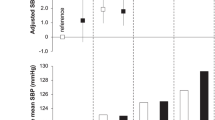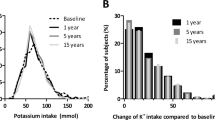Abstract
This study aimed to clarify the relationship between repeated measurements of casual (spot) and 24-h urinary sodium-to-potassium (Na/K) ratios in patients with chronic kidney disease (CKD). A total of 61 inpatients with CKD, 31 in stage 1–3 (eGFR [estimated glomerular filtration rate] ≥ 30 ml/min/1.73 m2) and 30 in stage 4–5 (eGFR < 30 ml/min/1.73 m2), aged 20–85 consuming a low-sodium diet (NaCl [sodium chloride] 6 g/day) were recruited. Urinary Na, K, and Na/K ratios were measured in both casual urine samples and 2-day, 24 h urine samples, and then analyzed by correlation and Bland–Altman analyses. Mean 24-h urine Na/K ratio was higher in participants in stage 4–5 (5.1) than in participants in stage 1–3 (4.1) CKD. Casual urine Na/K ratio was strongly correlated with 2-day, 24-h urine Na/K ratio by sampling 4 casual urine specimens every morning and evening in participants in stage 1–3 (r = 0.69–0.78), but not in stage 4–5 (r = 0.12–0.19). The bias for mean Na/K ratio between 2-day, 24-h urine, and the 4 casual urine sampling ranged from −0.86 to 0.16 in participants in stage 1–3, and the quality of agreement for the mean of this casual urine sampling was similar to that of sampling 8 casual urine samples for estimating 2-day, 24-h values. Methods using repeated casual urine Na/K ratios may provide a reasonable estimation of 24-h urine Na/K ratio in normotensive and hypertensive as well as individuals with stage 1–3, but not stage 4–5 CKD.
This is a preview of subscription content, access via your institution
Access options
Subscribe to this journal
Receive 12 digital issues and online access to articles
$119.00 per year
only $9.92 per issue
Buy this article
- Purchase on Springer Link
- Instant access to full article PDF
Prices may be subject to local taxes which are calculated during checkout



Similar content being viewed by others
References
Levey AS, Coresh J, Balk E, Kausz AT, Levin A, Steffes MW, et al. National Kidney Foundation. National Kidney Foundation practice guidelines for chronic kidney disease: evaluation, classification, and stratification. Ann Intern Med. 2003;139(2):137–47. [Erratum in: Ann Intern Med. 2003 Oct 7;139:605]
K/DOQI clinical practice guidelines on hypertension and antihypertensive agents in chronic kidney disease. Am J Kidney Dis. 2004;43(5 Suppl 1):S1–290.
Brown IJ, Tzoulaki I, Candeias V, Elliott P. Salt intakes around the world: implications for public health. Int J Epidemiol. 2009 Jun;38:791–813.
Drewnowski A, Rehm CD, Maillot M, Mendoza A, Monsivais P. The feasibility of meeting the WHO guidelines for sodium and potassium: a cross-national comparison study. BMJ Open. 2015;5:e006625.
Guideline: sodium intake for adults and children. Geneva: World Health Organization (WHO); 2012. P.
Guideline: potassium intake for adults and children. Geneva: World Health Organization (WHO); 2012. P.
Whelton PK, Appel LJ, Sacco RL, Anderson CA, Antman EM, Campbell N, et al. Sodium, blood pressure, and cardiovascular disease: further evidence supporting the American Heart Association sodium reduction recommendations. Circulation. 2012;126:2880–9.
Hunter D Biochemical indicators of dietary intake. In: Willet W., Nutritional Epidemiology, Second Edition. Oxford University Press: New York, NY, USA, 1998, p. 174–243.
Pietinen PI, Findley TW, Clausen JD, Finnerty FA, Altschul AM. Studies in community nutrition: estimation of sodium output. Prev Med. 1976;5:400–7.
Liu K, Stamler J. Assessment of sodium intake in epidemiological studies on blood pressure. Ann Clin Res. 1984;16(Suppl 43):49–54.
Cogswell ME, Mugavero K, Bowman BA, Frieden TR. Dietary sodium and cardiovascular disease risk—measurement matters. N Engl J Med. 2016;375:580–6.
Dennis B, Stamler J, Buzzard M, Conway R, Elliott P, Moag-Stahlberg A, et al. INTERMAP Research Group. INTERMAP: the dietary data—process and quality control. J Hum Hypertens. 2003;17:609–22.
Cobb LK, Anderson CA, Elliott P, Hu FB, Liu K, Neaton JD, et al. American Heart Association Council on Lifestyle and Metabolic Health. Methodological issues in cohort studies that relate sodium intake to cardiovascular disease outcomes: a science advisory from the American Heart Association. Circulation. 2014;129:1173–86.
Lerchl K, Rakova N, Dahlmann A, Rauh M, Goller U, Basner M, et al. Agreement between 24-hour salt ingestion and sodium excretion in a controlled environment. Hypertension. 2015;66:850–7.
Kawasaki T, Itoh K, Uezono K, Sasaki H. A simple method for estimating 24 h urinary sodium and potassium excretion from second morning voiding urine specimen in adults. Clin Exp Pharmacol Physiol. 1993;20:7–14.
Tanaka T, Okamura T, Miura K, Kadowaki T, Ueshima H, Nakagawa H, et al. A simple method to estimate populational 24-h urinary sodium and potassium excretion using a casual urine specimen. J Hum Hypertens. 2002;16:97–103.
Brown IJ, Dyer AR, Chan Q, Cogswell ME, Ueshima H, Stamler J, et al. INTERSALT Co-Operative Research Group. Estimating 24-hour urinary sodium excretion from casual urinary sodium concentrations in Western populations: the INTERSALT study. Am J Epidemiol. 2013;177:1180–92.
Polonia J, Lobo MF, Martins L, Pinto F, Nazare J. Estimation of populational 24-h urinary sodium and potassium excretion from spot urine samples: evaluation of four formulas in a large national representative population. J Hypertens. 2017;35:477–86.
Huang L, Crino M, Wu JH, Woodward M, Barzi F, Land MA, et al. Mean population salt intake estimated from 24-h urine samples and spot urine samples: a systematic review and meta-analysis. Int J Epidemiol. 2016;45:239–50.
Iwahori T, Miura K, Ueshima H. Time to consider use of the sodium-to-potassium ratio for practical sodium reduction and potassium increases. Nutrients. 2017;9:E700.
INTERSALT: an international study of electrolyte excretion and blood pressure. Results for 24-h urinary sodium and potassium excretion. Br Med J. 1988;297:319–28.
Stamler J, Rose G, Stamler R, Elliott P, Dyer A, Marmot M. INTERSALT study findings. Public health and medical care implications. Hypertension. 1989;14:570–7.
Tzoulaki I, Patel CJ, Okamura T, Chan Q, Brown IJ, Miura K, et al. A nutrient-wide association study on blood pressure. Circulation. 2012;126:2456–64.
Perez V, Chang ET. Sodium-to-potassium ratio and blood pressure, hypertension, and related factors. Adv Nutr. 2014;5:712–41.
Cook NR, Obarzanek E, Cutler JA, Buring JE, Rexrode KM, Kumanyika SK, et al. Trials of Hypertension Prevention Collaborative Research Group. Joint effects of sodium and potassium intake on subsequent cardiovascular disease: the Trials of Hypertension Prevention follow-up study. Arch Intern Med. 2009;169:32–40.
Cook NR, Appel LJ, Whelton PK. Sodium intake and all-cause mortality over 20 years in the Trials of Hypertension Prevention. J Am Coll Cardiol. 2016;68:1609–17.
Cook NR, Cutler JA, Obarzanek E, Buring JE, Rexrode KM, Kumanyika SK, et al. Long term effects of dietary sodium reduction on cardiovascular disease outcomes: observational follow-up of the trials of hypertension prevention (TOHP). Br Med J. 2007;334:885–8. Epub 2007 Apr 20
Kieneker LM, Bakker SJ, de Boer RA, Navis GJ, Gansevoort RT, Joosten MM. Low potassium excretion but not high sodium excretion is associated with increased risk of developing chronic kidney disease. Kidney Int. 2016;90:888–96.
Iwahori T, Ueshima H, Ohgami N, Yamashita H, Miyagawa N, Kondo K, et al. Effectiveness of a self-monitoring device for urinary sodium/potassium ratio on dietary improvement in free-living adults: a randomized controlled trial. J Epidemiol. 2018;28:41–47.
Iwahori T, Miura K, Ueshima H, Chan Q, Dyer AR, Elliott P, et al. INTERSALT Research Group. Estimating 24-hour urinary sodium/potassium ratio from casual (“spot”) urinary sodium/potassium ratio: The INTERSALT Study. Int J Epidemiol. 2017;46:1564–72.
Iwahori T, Ueshima H, Miyagawa N, Ohgami N, Yamashita H, Ohkubo T, et al. Six random samples of casual urine on different days are sufficient to estimate daily sodium/potassium ratio as compared to 7-day 24-h urine collections. Hypertens Res. 2014;37:765–71.
Iwahori T, Ueshima H, Torii S, Saito Y, Fujiyoshi A, Ohkubo T, et al. Four to seven random casual urine specimens are sufficient to estimate 24-hr urinary sodium/potassium ratio in individuals with high blood pressure. J Hum Hypertens. 2016;30:328–34.
Matsuo S, Imai E, Horio M, Yasuda Y, Tomita K, Nitta K, et al. Collaborators developing the Japanese equation for estimated GFR. Revised equations for estimated GFR from serum creatinine in Japan. Am J Kidney Dis. 2009;53:982–92.
Bland J, Altman DG. Statistical methods for assessing agreement between two methods of clinical measurement. Lancet. 1986;1:307–10.
Iwahori T, Ueshima H, Torii S, Saito Y, Kondo K, Tanaka-Mizuno S, et al. Diurnal variation of urinary sodium-to-potassium ratio in free-living Japanese individuals. Hypertens Res. 2017;40:658–64.
Koeppen BM, Stanton BA. Renal transport mechanisms: NaCl and water reabsorption along the nephron. In: Koeppen BM, Stanton BA, Renal Physiology, Fifth Edition. Elsevier Inc.: Amsterdam, Netherlands, 2013. p. 45–71.
Dhondup T, Qian Q. Electrolyte and acid-base disorders in chronic kidney disease and end-stage kidney failure. Blood Purif. 2017;43:179–88.
Acknowledgments
This study was conducted by Okayama University hospital in cooperation with the Department of Public Health, Shiga University of Medical Science. HAU and TI contributed to the design of the study. HAU, YO, and AK participated in data collection. HAU, TI, and YO participated in data analysis and contributed to manuscript drafting. All authors participated in critical revision of the manuscript. All authors approved the final version of the manuscript for submission. The authors thank Mrs. Debra L. Rateri (University of Kentucky) for skillful English editing.
Funding
This work was supported by a scientific research grants from Japanese Study Group for Physiology and Management of Blood Pressure.
Author information
Authors and Affiliations
Corresponding author
Ethics declarations
Conflict of interest
Dr. Haruhito A. Uchida belongs to the Department of Chronic Kidney Disease and Cardiovascular Disease which is endowed by Chugai pharmaceutical, MSD, Boehringer Ingelheim, and Kawanishi Holdings. Dr. Toshiyuki Iwahori was an employee of OMRON HEALTHCARE Co., Ltd. until March, 2018. Dr. Hirotsugu Ueshima served as a consultant for this project. Dr. Katsuyuki Miura received a research grant from OMRON HEALTHCARE Co., Ltd.
Electronic supplementary material
Rights and permissions
About this article
Cite this article
Okuyama, Y., Uchida, H.A., Iwahori, T. et al. The relationship between repeated measurement of casual and 24-h urinary sodium-to-potassium ratio in patients with chronic kidney disease. J Hum Hypertens 33, 286–297 (2019). https://doi.org/10.1038/s41371-018-0127-1
Received:
Revised:
Accepted:
Published:
Issue Date:
DOI: https://doi.org/10.1038/s41371-018-0127-1
This article is cited by
-
Relationship between the urinary Na/K ratio, diet and hypertension among community-dwelling older adults
Hypertension Research (2023)
-
Consideration of the reference value and number of measurements of the urinary sodium-to-potassium ratio based on the prevalence of untreated home hypertension: TMM Cohort Study
Hypertension Research (2022)
-
Association between the urinary sodium-to-potassium ratio and renal outcomes in patients with chronic kidney disease: a prospective cohort study
Hypertension Research (2021)
-
Assessment and validation of spot urine in estimating the 24-h urinary sodium, potassium, and sodium/potassium ratio in Chinese adults
Journal of Human Hypertension (2020)



